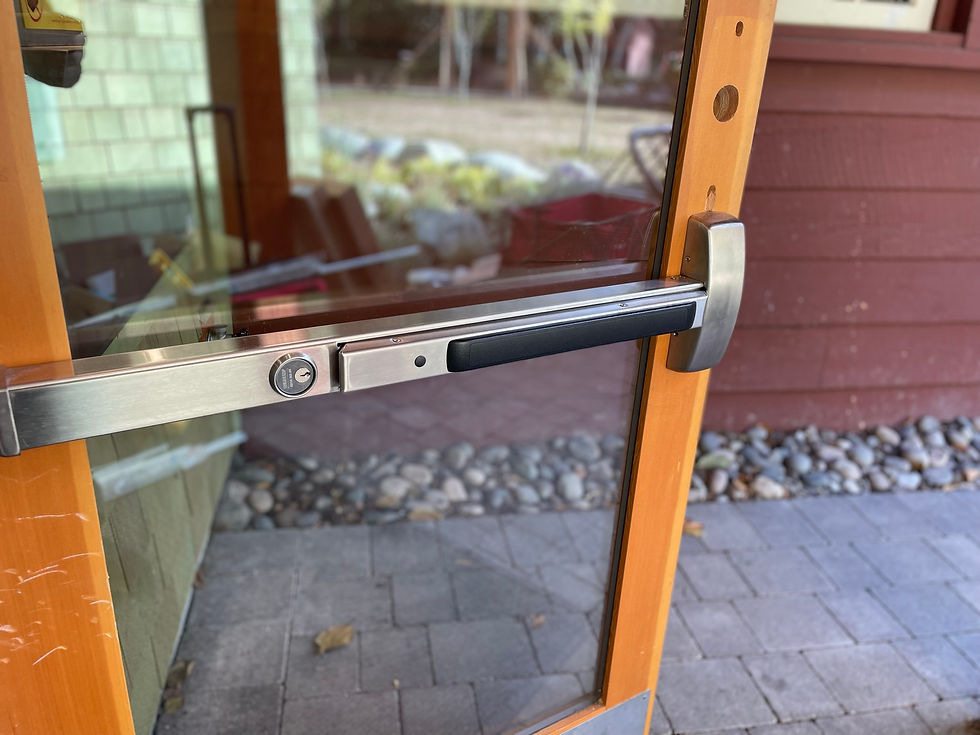The rise of contactless automatic door openers in the post-pandemic world
- Joe Miller
- Apr 24, 2023
- 5 min read
In the post-pandemic world, contactless automatic door openers are becoming an increasingly popular option for businesses and public places. With the rise of health and safety protocols, contactless technology is a great way to ensure that visitors can enter your building without having to come into physical contact with surfaces.
Contactless automatic door openers offer many benefits over traditional doors including increased hygiene, convenience, security, and energy efficiency. In this blog post, we'll discuss the different types of contactless automatic door openers available on the market today as well as how to install one in your business or facility. We'll also look at some of their advantages and disadvantages as well as cost considerations when installing one in your space. Finally, we’ll explore what the future may hold for automated doors in our new reality.
Overview of contactless automatic door openers
Contactless automatic door openers have rapidly gained popularity in recent years due to their convenience and safety benefits. These door openers use advanced sensor technology to detect motion and automatically open and close doors without any physical contact. This means people with disabilities or limited mobility can easily access buildings without struggling to open heavy doors. Additionally, in today's world where hygiene is a top priority, contactless automatic door openers minimize the spread of germs by eliminating the need to touch door handles. Whether in a hospital, office, or any public space, contactless automatic door openers are a game-changer in providing a safe and accessible environment for everyone.
The percentage of touchless buttons is also growing rapidly. Touchless buttons are actuated by a user’s presence, such as when someone stands in front of the door, passes by the door, and mainly waves at the button/sensor to activate the signal and open the door automatically.
Benefits of using contactless technology in the post-pandemic world
The world has been forever changed by the pandemic, and there's no denying that contactless technology is becoming more commonplace. This type of technology allows people to complete transactions, pay for goods, and access services without the need for physical contact. Not only is it more convenient, but using contactless technology also reduces contact with potentially harmful bacteria and viruses. In the post-pandemic world, the benefits of contactless technology are clear. It's efficient, safe, and enables us to maintain physical distance while still accessing the goods and services we need. With the world adapting to a new normal, contactless technology is proving to be an invaluable tool in creating a safer, more convenient world for all of us.
When customers are contacting us, they are looking for cost-effective solutions that can help them create a safe and clean environment. Many of our clients have turned towards contactless automatic door openers to help them meet their goals and we have experienced a surge in demand for this type of technology.
Different types of contactless automatic door openers available on the market
With the rise of contactless technology, door openers are keeping up with the trend as well. There are now various types of contactless buttons available on the market for opening automatic doors. Wave-to-open sensors usually work by connecting a wire to the door operator, which supplies power and receives a signal to open the door when someone waves their hand in front of the sensor. The latest developments include the availability of Bluetooth-enabled buttons that can function with both hard-wiring and with simple double AA batteries. This solution works well in situations where wiring is unavailable or too complicated.
People often confuse motion sensors with touchless buttons, but they are actually two distinct technologies. The main difference is that a wave-to-open button still requires a person to consciously wave at the sensor to activate the opening, whereas a motion sensor detects any movement in a predefined area and automatically opens the door. When using a motion sensor on a door, it is necessary to install safety sensors and beams. However, wave-to-open buttons do not require any additional safety sensors in most cases. Different rules and regulations apply to these two types of sensors.
Contactless buttons typically have two lights, green and red, that indicate whether or not the button has recognized the signal. Each type of button guarantees contact-free and convenient access for users. Bluetooth-enabled buttons can also be controlled via smartphone or smartwatch, adding an extra layer of convenience. However, this feature is not very common.
With these options available, opening doors has become easier, safer, and more hygienic than ever before.
How to install a contactless automatic door opener
It is important to note that a certified technician should install a contactless automatic door opener. However, many people are unaware that in most instances, the existing push-to-open buttons can be replaced with wave-to-open sensors. This makes it easier to upgrade existing doors and door openers, as the wiring would remain the same or will be replaced with battery-operated buttons.
When installing a wave-to-open sensor, a technician should first ensure that the correct type of button is used for the application. The technician should also follow all applicable safety regulations and building codes and be sure to wire the button correctly so that it functions.
Advantages and disadvantages of using a contactless automatic door opener
Imagine walking up to a door and it automatically opening, without you having to push a button or even touch the handle. That's the convenience of a contactless automatic door opener. One major advantage is that it can prevent the spread of germs, especially during a pandemic as we've seen recently. You don't have to worry about touching a contaminated door handle or pushing on a dirty push plate. However, these systems do have some disadvantages. The installation and maintenance costs for them are higher than the typical push plate, and most buttons rely on electricity, which can create a more complicated installation process. Additionally, there are some rear cases where a reflection of sunlight directly at the sensor can activate the button and send an opening signal to the door operator. Overall, it is important to weigh the pros and cons before deciding whether a contactless automatic door opener is right for you.
Cost considerations for installing a contactless automatic door opener
When it comes to installing a contactless automatic door opener, the cost is undoubtedly a crucial consideration. While the benefits of contactless technology in public spaces are clear, the cost may deter some businesses or organizations from investing in the necessary upgrades. However, it's important to weigh the initial investment against the potential long-term benefits, such as improved accessibility and increased safety for visitors and employees alike. Additionally, there may be financing options or grants available to offset the cost. Ultimately, it's up to each business or organization to make the decision that is best for their budget and needs.
The future of automated doors in the post-pandemic world - Conclusions
As the world adapts to life after the pandemic, it's clear that technological advancements will play a crucial role in keeping people safe and healthy. One area in particular that will see a boost is touchless technologies such as automated doors. No longer considered a luxury, touchless entry is becoming the norm. With the aging population, the convenience of automated doors was already being recognized pre-pandemic, but now, they are being viewed as a vital component of keeping public spaces safe by minimizing contact with high-touch surfaces. The technology also has the added benefit of being energy-efficient and providing better access for people with disabilities. It's exciting to think about what the future holds for automated doors, and how they will continue to evolve to meet changing needs.



















